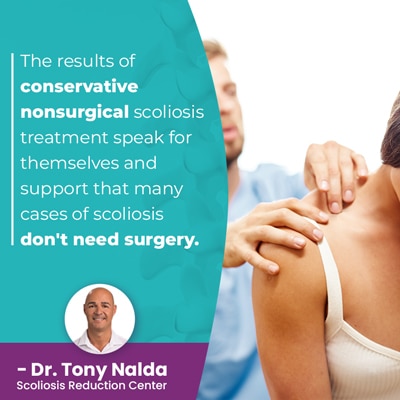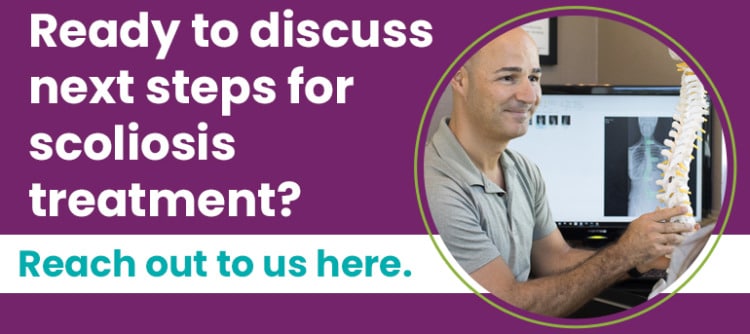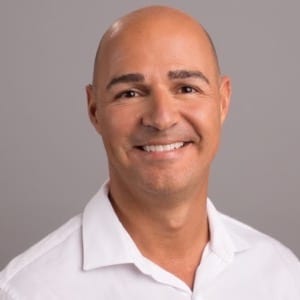Scoliosis Surgery Success Rates: What the Data Shows

There are different ways to treat scoliosis, and scoliosis surgery success rate specifically addresses the procedure and its immediate results, but this doesn't indicate quality of life or the surgery's long-term effects on spinal health. Conservative treatment options prioritize the spine's long-term health and function.
The data shows that scoliosis surgery, specifically spinal fusion, fixes scoliosis in approximately 70 percent of cases, but there is a significant risk of long-term complications and disruptions to spinal health and function. Data also shows that many patients don't need surgical intervention.
While the data shows that spinal fusion can successfully stop scoliosis from progressing in most cases, studies also show that many patients experience negative long-term effects.
Table of Contents
Scoliosis Surgery
Scoliosis surgery is a type of spinal fusion and has the goal of stopping scoliosis from progressing.
Scoliosis is a structural spinal condition that causes the spine to develop an unhealthy and unnatural sideways-bending spinal curve that also rotates, making it a complex 3-dimensional condition.
As a progressive condition, its nature is to get worse over time; the size and rotation of the spinal curve will increase and the condition's effects will become more overt.
In addition, the more severe a condition, the more likely it is that surgical intervention will be necessary.
Scoliosis ranges in severity from mild scoliosis to moderate, severe, and very severe cases, and while there are never treatment guarantees, the sooner treatment is started, the better.
Milder curves are simpler to correct, but it's not always easy to diagnose scoliosis while mild because its effects are also mild.
Scoliosis surgery is generally recommended when/if conditions become severe or very severe and show signs of continued progression.
Condition severity is determined by a measurement of the curve's most-tilted vertebrae known as Cobb angle, and on the path of traditional scoliosis treatment, spinal fusion is recommended for severe cases with Cobb angles of 45+ degrees.
Spinal fusion has the goal of stopping the condition from progressing and does so by fusing the curve's most-tilted vertebrae into one solid bone to eliminate movement; this can involve the removal of intervertebral discs that sit between adjacent vertebrae to be fused.
Metal rods are attached to the spine with pedicle screws to hold the spine's alignment, and hardware attached is permanent, as are the effects of spinal fusion surgery.
Scoliosis Surgery Success Rate
 In terms of stopping progression, spinal fusion surgery has a success rate of approximately 70 percent, with overall complication rates of between 10.5 and 41.2 percent.
In terms of stopping progression, spinal fusion surgery has a success rate of approximately 70 percent, with overall complication rates of between 10.5 and 41.2 percent.
Once a spine is fused, it's fused for life, and if there are any complications, the only recourse is a revision surgery, and the risk factors increase with each subsequent procedure and increasing patient age.
While a 70-percent success rate is positive, studies also show that no higher than 30, 15, and 5 percent will experience a positive surgical outcome after their second, third, and fourth spinal surgery.
Spinal fusion is invasive and risky and while it can address a structural issue like scoliosis, there are certain risks associated with the procedure itself, and there are certain long-term effects patients need to be aware of.
Spinal Fusion Risks
Considering the complexity of the spine and its role in working with the brain to establish the body's central nervous system, any type of nerve damage can be severe and cause a number of symptoms.
Spinal fusion comes with the potential risks of excessive blood loss, infection, nerve damage, and an adverse reaction to hardware used.
Each patient will respond to surgery in their own way; important factors include whether or not there were any complications during the procedure, the type of scoliosis, severity, location of the scoliosis within the spine, and the number of vertebrae fused.
Effects of Spinal Fusion on Spinal Health
While the immediate risks of spinal fusion surgery can be significant, the long-term effects are more likely to shape a patient's quality of life over time.
The spine's natural curves make it stronger, more flexible, and better able to handle mechanical stress during activity, and the design of the spine is based on movement, so fusing even a small portion to eliminate movement is contrary to the spine's natural design and purpose.
A spine that's fused is not going to be as flexible, and a reduced range of motion in the spine can also mean activity restrictions.
While some patients maintain enough flexibility above and below the fusion site to not notice a significant difference, others are disappointed in the rigidity of their spines post spinal fusion surgery.
A spine that's rigid can also be painful, and pain at the fusion site is another common effect.
A spine that's fused is also weaker and more vulnerable to injury, and keep in mind, the younger a patient is at the time of the spinal fusion, the longer the hardware has to last and perform optimally inside the body.
Scoliosis patients need to fully understand the risks of childhood and adult scoliosis surgery and that there are additional treatment options available that don't come with the same potential risks, side effects, and complications.
Nonsurgical Scoliosis Treatment
 The results of conservative nonsurgical scoliosis treatment speak for themselves and support that many cases of scoliosis don't need surgery.
The results of conservative nonsurgical scoliosis treatment speak for themselves and support that many cases of scoliosis don't need surgery.
While clinical outcomes will vary, operative versus nonoperative treatment is more risky and doesn't preserve the spine's natural strength and function to the same level.
While spinal fusion surgery can fix scoliosis in approximately 70 percent of cases, patient satisfaction can change over time, particularly for patients experiencing a noticeable loss in spinal flexibility and range of motion.
Conservative treatment is what patients of the Scoliosis Reduction Center® benefit from; it offers a surgical alternative that's less invasive and can also offer impressive curve correction results.
Conservative treatment has the goal of a balanced spine and is minimally invasive because it works towards 3-dimensional correction on a structural level.
Nonsurgical Treatment Disciplines
Through the application of chiropractic care that involves a series of techniques and manual adjustments, the spine's alignment can be improved, restoring as much of the spine's natural curves as possible.
Chiropractic care has to be scoliosis-specific for corrective potential and can restore the spine's balance and stability, which improves the body's overall alignment and the condition's effects.
A misaligned spine can mean a body that's out of balance, affecting appearance and movement.
Physical therapy and scoliosis-specific exercise programs can help support structural changes within the spine by improving the spine's surrounding muscle balance and strength.
A common effect of scoliosis is the development of a muscular imbalance as the spine's surrounding muscles are pulled in different directions to counteract the unnatural spinal bend and twist.
A stronger core means more support and stability for the spine, better posture, and increased spinal flexibility, and a strong core can be maintained for sustainable treatment results.
Corrective bracing can help by pushing the spine into a straighter alignment and is a common facet of childhood scoliosis treatment.
The ScoliBrace® is the world's most advanced corrective brace and shows impressive results in adolescent idiopathic scoliosis patients.
Exercises to further heal and stabilize the spine can be prescribed so patients can establish an effective home-rehabilitation program, and lifestyle guidance is part of helping patients develop a scoliosis-friendly lifestyle throughout treatment and beyond.
Conclusion
While scoliosis surgery has an approximate 70-percent success rate, the procedure still comes with a number of potential risks, side effects, and complications.
Many cases of scoliosis can be treated successfully with nonsurgical treatment, and with the Scoliosis Research Society estimating close to seven million cases in the United States alone, awareness is important and can lead to early detection.
There are direct links between early detection, intervention, and the success of nonoperative treatment.
All surgical procedures come with their share of risks, and the potential risks of spinal fusion include procedural risks such as excessive blood loss, infection, and nerve damage, and long-term effects can include a spine that's weaker, more easily injured/strained, and less flexible with a reduced range of motion.
Nonsurgical scoliosis treatment that includes corrective bracing has shown successful curve reduction rates as high as 72 percent.
Here at the Center, an integrative treatment approach is applied that combines the power of chiropractic care, physical therapy, exercise-based treatment, corrective bracing, and rehabilitation.
With surgical and nonsurgical treatment, there are never treatment guarantees, but scoliosis that's left untreated can become more severe over time and develop complications; the sooner treatment is started, the better.
Following a diagnosis of scoliosis, the most important decision is how to treat it moving forward, so don't hesitate to reach out for guidance; a big part of my approach involves educating patients and their families on all treatment options available.
Dr. Tony Nalda
DOCTOR OF CHIROPRACTIC
After receiving an undergraduate degree in psychology and his Doctorate of Chiropractic from Life University, Dr. Nalda settled in Celebration, Florida and proceeded to build one of Central Florida’s most successful chiropractic clinics.
His experience with patients suffering from scoliosis, and the confusion and frustration they faced, led him to seek a specialty in scoliosis care. In 2006 he completed his Intensive Care Certification from CLEAR Institute, a leading scoliosis educational and certification center.
About Dr. Tony Nalda
 Ready to explore scoliosis treatment? Contact Us Now
Ready to explore scoliosis treatment? Contact Us Now





